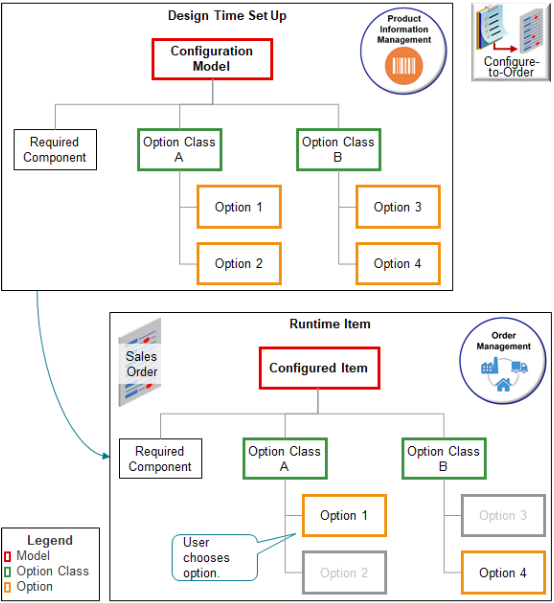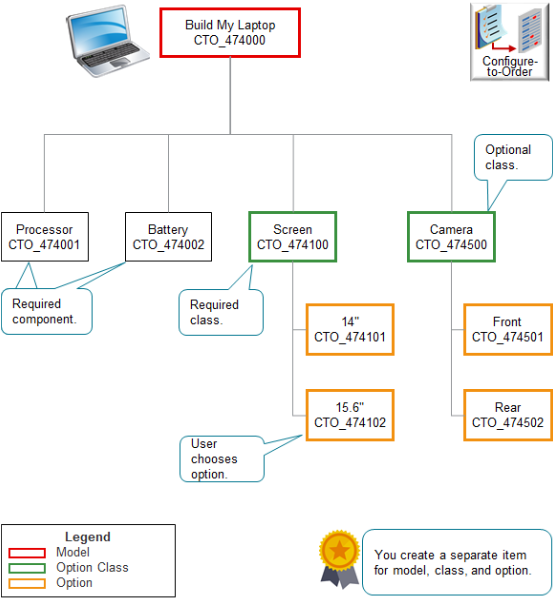Overview of Configure-to-Order
Use configure-to-order so you can choose options for each component of a configured item.
For example, order a laptop computer with a 1 terabyte hard drive. The computer is an example of a configured item. The hard drive is an example of a configure option. 1 terabyte and 500 megabytes are each values your customer can choose for the option. A configured item can include more than one configure option. A laptop computer can include other options, such as memory, the display, color of the chassis, and so on.
Configure-to-order is the process of ordering and fulfilling a configured item.
Why Should I Use Configure-to-Order?
-
It's expensive to build and stock supply for all the different possible combinations of options, store it in inventory, then wait for your customers to order. Instead, you can use just-in-time manufacturing and other manufacturing processes, such as postponement, to build the item on demand, when and where you order it.
-
Some options rarely sell, but when they do sell, they meet an important customer requirement.
-
Some items cost a lot of money and are expensive to maintain as on-hand inventory.
-
Some items are physically large and not practical to stock in every possible combination.
-
Modeling each configured item separately improves handling and helps the warehouse and shop floor to identify and manage the item.
-
Improve visibility for the item and on-hand quantities in inventory, promising, and planning.
What's a Configuration Model?
Here's a generic structure of a configuration model.

Here are some important concepts.
|
Concept |
Description |
|---|---|
|
Configuration model |
A structure that specifies the options that you can choose for each component. You can also specify that a component is required. You specify the model during set up. You don't order or build the model at runtime. |
|
Option class |
An object that you use to organize configure options. |
|
Configure option |
Child of an object class. The hard drive, monitor, and mouse are each an example of a configure option. You can choose the value for a configure option from a list of available options at run time. |
|
Configured item |
An item that includes one or more configure options that your user chooses. A desktop computer where you choose the hard drive, monitor, and mouse is an example of a configured item. A configured item is the result of the choices that you make at run time. |
|
Required component |
Component in the model that you can't choose. For example, you usually can't choose the cooling fan when you order a laptop computer. |
Note
-
You create the model, classes, options, and structure in the Product Information Management work area at design time.
-
You choose options in the Order Management work area in a sales order at run time.
Example
Here's an example of a configuration model.

Note
-
The model, each option class, and each option are separate items that you create in the Product Information Management work area. For example, CTO_474000 is the item name for the model, CTO_474100 is the name of the screen option class, and CTO_474101 is the name of the 14" screen option.
-
The processor and battery are required components in this model. You can't order a laptop without them.
-
The screen option class is required. You can't order a laptop without a screen, but you can order a 14" screen or 15.6" screen.
-
The camera option class is optional. You can order a laptop without a camera. If you add a camera, then you can add a front camera, rear camera, or front and rear camera.
-
You choose the options at run time.
You use the Product Information Management work area to create the structure. For example:
-
Create an item for each screen option.
-
Create an item for the screen option class, then add the screens to the class.
-
Create the model, then add the option class to the model.
Types of Configurations
|
Configuration |
Description |
|---|---|
|
Assemble-to-order (ATO) |
Item that isn't yet manufactured and isn't ready to ship. You make it or procure it according to the options that you select at run time. A warehouse usually doesn't stock every possible set of options that you might select. Instead, the warehouse receives the work order, then:
|
|
Pick-to-order (PTO) |
Item where you already manufactured the components, or you must make or purchase them.
|
|
Hybrid |
A pick-to-order item that contains at least one assemble-to-order component. |